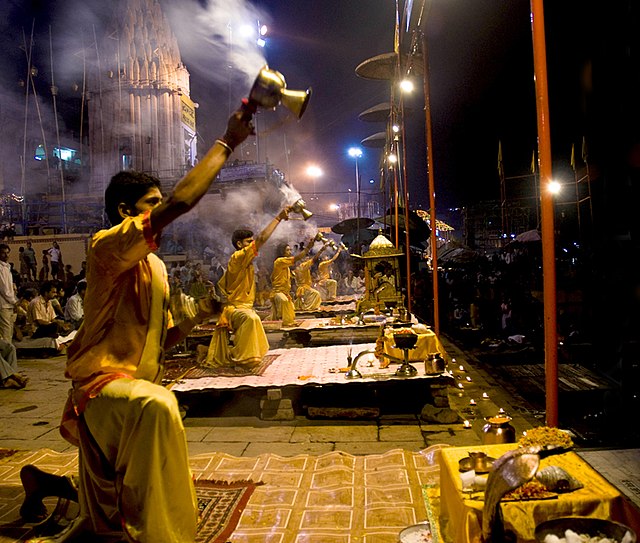The Spiritual Significance of Ganga Aarti: A Divine Celebration in Varanasi

In the ancient city of Varanasi, where the sacred waters of the Ganges River flow, a timeless tradition unfolds each evening, captivating the hearts and minds of pilgrims and visitors alike. This tradition is known as Ganga Aarti, a mesmerizing ritual of light and devotion that holds profound spiritual significance in Hinduism. In this exploration, we delve into the spiritual essence of Ganga Aarti, uncovering the depth of its symbolism and the richness of its cultural heritage.
1. The Setting: Varanasi, City of Light
Varanasi, also known as Kashi or Benares, is one of the oldest inhabited cities in the world and a revered pilgrimage site for Hindus. It is believed to be the abode of Lord Shiva, the supreme deity of Hinduism, and the spiritual center of the universe. Against this backdrop of ancient temples, winding lanes, and ghats (riverfront steps), the Ganga Aarti ceremony takes place each evening, drawing worshippers and spectators from near and far.
2. The Ritual: A Symphony of Light and Sound
Ganga Aarti is a choreographed ritual that unfolds with meticulous precision, combining music, chanting, and the offering of lamps to the river goddess Ganga. As dusk descends and the shadows lengthen, priests clad in traditional attire gather on the ghats, facing the sacred river. Accompanied by the melodious strains of ancient hymns and the rhythmic beating of drums, they perform elaborate gestures with brass lamps, creating a mesmerizing display of light and movement.
3. Symbolism and Significance
At its core, Ganga Aarti is a symbolic offering of reverence and gratitude to the Ganges River, which is venerated as a goddess in Hinduism. The lamps symbolize the divine light of knowledge and the dispelling of darkness, while the flowing waters of the Ganges represent purity, renewal, and liberation from the cycle of birth and death. Through the ritual of Ganga Aarti, worshippers seek blessings for health, prosperity, and spiritual enlightenment.
4. Devotion and Faith
For devotees, attending Ganga Aarti is not merely a spectator experience but a deeply spiritual act of devotion and faith. As they gather on the ghats, they offer prayers, light incense sticks, and float flower garlands on the river as offerings to the goddess Ganga. Many believe that witnessing Ganga Aarti and bathing in the sacred waters of the Ganges can purify the soul, wash away sins, and bestow blessings for this life and the afterlife.
5. Cultural Heritage and Tradition
Ganga Aarti is not only a religious ritual but also a cultural heritage that has been passed down through generations in Varanasi. The ceremony is steeped in ancient tradition and symbolism, reflecting the timeless wisdom of Hindu philosophy and the vibrant tapestry of Indian culture. As one of the most iconic rituals in Varanasi, Ganga Aarti attracts visitors from around the world who come to witness its beauty and experience its spiritual resonance.
6. Preservation and Promotion
Efforts are underway to preserve and promote the tradition of Ganga Aarti, ensuring that it continues to thrive for future generations. Various organizations and religious institutions collaborate to organize and facilitate the ceremony, providing infrastructure, training for priests, and support services for worshippers. Additionally, initiatives such as cultural festivals and tourism promotion aim to raise awareness of Ganga Aarti's significance and attract visitors to Varanasi.
7. Experiencing Ganga Aarti: Tips for Visitors
For those planning to attend Ganga Aarti in Varanasi, it is essential to arrive early to secure a good vantage point along the ghats. It is also advisable to dress modestly and respectfully, as Ganga Aarti is a sacred ceremony. Visitors should be prepared for large crowds and a bustling atmosphere, especially during peak tourist seasons. Finally, it is essential to approach the ceremony with an open heart and mind, ready to immerse oneself in the spiritual energy and divine grace of Ganga Aarti.
Conclusion
In conclusion, Ganga Aarti is more than just a religious ritual; it is a profound expression of devotion, gratitude, and reverence for the sacred waters of the Ganges River. As worshippers gather each evening to participate in this ancient tradition, they are reminded of the eternal flow of life, the cycle of creation and destruction, and the timeless presence of the divine in the world. Through the luminous spectacle of light and sound, Ganga Aarti illuminates the spiritual path and guides seekers toward inner peace, enlightenment, and union with the divine.
